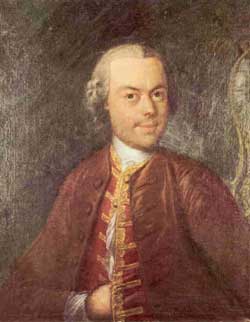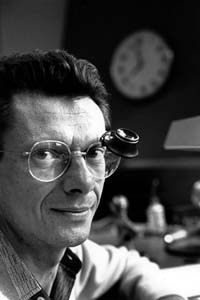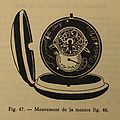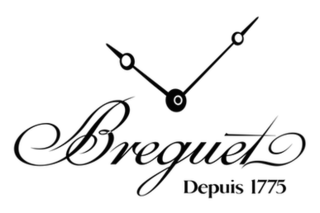Working period
On the 26 December 1769 Louis George applied for the patent as the royal watchmaker and succeeded. He was allowed to call himself from now on “Horloger du Roy” — in English, "watchmaker to the king". French was the language of the Berlin nobility.
The literature on Louis George reports different working periods. The writer Gerhard Koenig states in his book a working period from 1769 to 1796. The address calendar of Berlin lists the Louis George in the editions of the years 1799 and 1801.
The addresses of Louis George's workshops mentioned at the Berlin Adresskalender are Schlossplatz 10 and 13 (in 1799) and Schlossplatz 10 in (1801), right opposite the Stadtschloss (city palace) of Berlin. Starting in 1815 Louis George et compagnie produced lever pocket watches, most probably a son of the royal watchmaker.
Watchmaker to the King
Louis George was a talented watchmaker and artist. He did not just create watches but real gems of watch making. His posh watches enchanted the audience and recovered the respect of the Berlin nobility and solvent bourgeoisie. His business flourished and he was capable of opening a second shop in the same street opposite the royal city palace.
Located at Berlin he provided watches for three generations of Prussians kings:
Other German monarchs appreciated the masterly crafted clocks and watches too. A long case clock with an organ movement formerly owned by Georg I. Duke of Saxe-Meiningen is preserved on castle of Elisabethenburg at Meiningen. It can be visited at the art collection of the Meininger Museen at the Schloss Elisabethenburg Inventory-No. II 1908, height 2,93 m. approx. 1790; watch dial reads: „Ls. GEORGE HORLOGER DU ROY“ / „A BERLIN“. The curator M. Ruszwurm reports that clock is equipped with a precious flute watch (also called organ watch).
A console clock with an attached flute work is exhibited at the Schloss Sanssouci at Potsdam.
Louis George long case clock of Georg I. Duke of
Saxe-Meiningen Clock dial of a Louis George console clock at
Sanssouci Louis George alcove clock with an attached bronze flute work, auctioned 2005 in Paris
Louis George lever watch, face
Louis George lever watch, back
Louis George pocket watch, made in
Berlin about 1810, photo: Dr.Ilk, Munich, Germany
Entry of the address of Louis George at the Berlin address book of 1769

Abraham-Louis Breguet, born in Neuchâtel, then a Prussian principality, was a horologist who made many innovations in the course of a career in watchmaking industry. He was the founder of the Breguet company, which is now the luxury watch division of the Swiss Swatch Group.

An automaton is a relatively self-operating machine, or control mechanism designed to automatically follow a sequence of operations, or respond to predetermined instructions. Some automata, such as bellstrikers in mechanical clocks, are designed to give the illusion to the casual observer that they are operating under their own power or will, like a mechanical robot. The term has long been commonly associated with automated puppets that resemble moving humans or animals, built to impress and/or to entertain people.

Pierre Jaquet-Droz was a watchmaker of the late eighteenth century. He was born on 28 July 1721 in La Chaux-de-Fonds, in the Principality of Neuchâtel, which was then part of the Kingdom of Prussia. He lived in Paris, London, and Geneva, where he designed and built animated dolls known as automata to help his firm sell watches and mechanical caged songbirds.

Ferdinand Berthoud, was a scientist and watchmaker. He became master watchmaker in Paris in 1753. Berthoud, who held the position of Horologist-Mechanic by appointment to the King and the Navy, left behind him an exceptionally broad body of work, in particular in the field of marine chronometers.

ETA SA Manufacture Horlogère Suisse designs and manufactures quartz watches and both hand-wound and automatic-winding mechanical ébauches and movements. Commonly referred to as ETA, the company is headquartered in Grenchen, Switzerland, and is a wholly owned subsidiary of The Swatch Group.

Oris SA is a Swiss luxury manufacturer of mechanical watches. The company was founded in 1904 and is based in Hölstein in the canton of Basel-Landschaft.

La Chaux-de-Fonds is a Swiss city in the canton of Neuchâtel. It is located in the Jura mountains at an altitude of 1000 m, a few kilometres south of the French border. After Geneva, Lausanne and Fribourg it is the fourth largest city in the Romandie, the French-speaking part of the country, with a population of 36,915.

Glycine Watch SA, or simply Glycine, is a Swiss watchmaker founded in 1914 in Biel/Bienne (BE), Switzerland, where its manufacturing and headquarters remain today. In 1930, Glycine released the first mass-produced automatic watches, and in 1959, it developed vacuum-sealed cases, allowing for more durable and water-resistant timepieces. The Glycine Airman, the first watch capable of tracking two 24-hour time zones, has been used extensively in commercial and military aviation, as well as in spaceflights; notable examples include its use by United States Air Force pilots during the Vietnam War and astronaut Pete Conrad during the Gemini 5 and Gemini 11 spaceflights.

The International Museum of Horology, French: Musée international d'horlogerie, is a horological museum in La Chaux-de-Fonds, Switzerland. It is owned and operated by the city of La Chaux-de-Fonds.
Léon Louis Gallet (1832–1899), watchmaker, entrepreneur, philanthropist, and past family patriarch of the Gallet Watch Company of Switzerland, is considered as one of the primary architects and founders of the 19th century industrialization of the Swiss watchmaking industry.

Gallet (ˈgæl.eɪ) is a historic Swiss manufacturer of high-end timepieces for professional, military, sports, racing, and aviation use. Gallet is the world's oldest watch and clock making house with history dating back to Humbertus Gallet, a clock maker who became a citizen of Geneva in 1466. The Gallet & Cie name was officially registered by Julien Gallet (1806–1849) in 1826, who moved the family business from Geneva to La Chaux-de-Fonds, Switzerland. Prior to this date, operations commenced under the name of each of the Gallet family patriarchs.

Jean-François Bautte was a Swiss watchmaker and jeweller famous for several reasons: he founded the most complete watch manufacture of his time in Geneva. He also created watches and jewellery for famous people and was one of the inventors of the extra-thin watch.

Mathey-Tissot is a Swiss watch maker of prestige watches, originally established in 1886 by Edmond Mathey-Tissot at Les Ponts-de-Martel in the canton of Neuchâtel in Switzerland.

Jean-Antoine Lépine, born as Jean-Antoine Depigny, was an influential watchmaker. He contributed inventions which are still used in watchmaking today and was amongst the finest French watchmakers, who were contemporary world leaders in the field.

Dominique Loiseau was a French and Swiss watchmaker who worked at the highest levels of complex horology from the mid 1970s onwards He was the creator of several notable timepieces, including six Montres de Sables, the Rose de Temps clock, the Renaissance or Capriccio pocket watches and the Blancpain 1735 wristwatch. In 2011 he presented, the Loiseau 1f4, one of the most complicated automatic watches with eight patents. Loiseau announced in 2012 a collaboration with Swiss watch manufacturer Girard-Perregaux.

Charles Oudin is one of the oldest French horology firms. It was founded in Paris at the end of the 18th century by Jean-Charles Oudin, who came from a family of clockmakers in Northwest France. There were four generations of Oudins who were clockmakers, as of the mid 18th century, first in the Meuse region and later, in Paris. Several members of the Oudin family worked for the master watch and clockmaker Abraham-Louis Breguet.


























